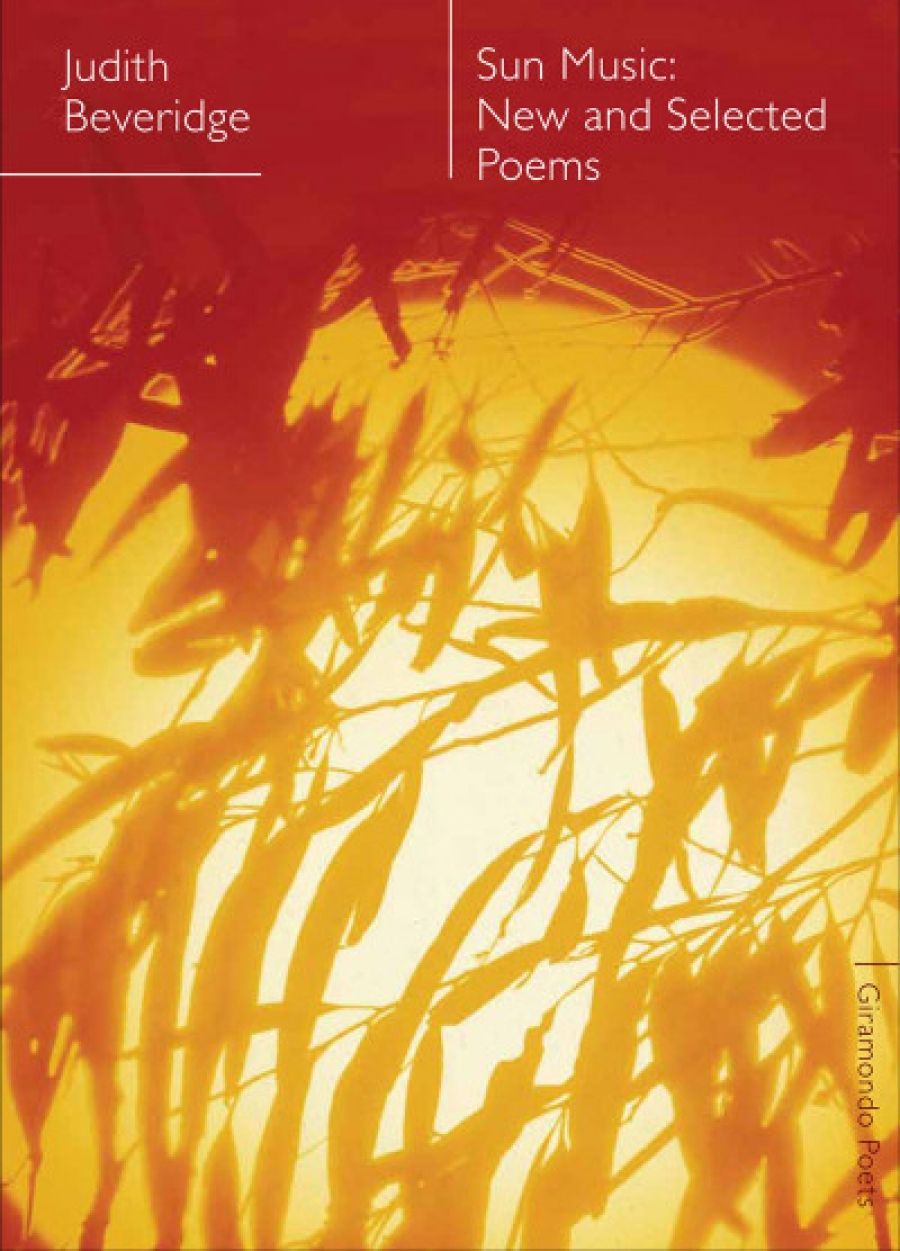
- Free Article: No
- Contents Category: Poetry
- Custom Article Title: Judith Bishop reviews 'Sun Music: New and selected poems' by Judith Beveridge
- Review Article: Yes
- Online Only: No
- Custom Highlight Text:
The appearance of a New and Selected Poems by a widely loved and admired poet has all the pleasures of a major retrospective, but viewed alone, without the clamour of a gallery event. It’s in the nature of retrospective to raise the banner of analysis-as-public-spectacle. What does this art mean ...
- Book 1 Title: Sun Music
- Book 1 Subtitle: New and selected poems
- Book 1 Biblio: Giramondo, $26.95 pb, 238 pp, 9781925336887
Sun Music is a sensual banquet for the reader, as expected from the books it draws from: storm, egret and heron, fish, bush, beach, and river are present to the senses. Like landforms and contours viewed from a height, continuities and departures become evident as one moves through the volume. Visual and, especially, auditory images, scaffolded at times by the repetition of a frame like ‘Perhaps’ or ‘I want’, shape many of these poems into quite overt structures of attention and perception. Often the voice of the poems is out walking, observing the world and coining apt analogies for what appears most striking. And often these analogies are multiple, joined by ‘or’, as if to acknowledge that no one image will ever be adequate to capture the mind and body’s encounter with the real:
Some of the bats are elbowing their way
along the branches, a collection of
broken
business umbrellas. Some hang like
charred
pods, or look like furry oriental fruit
wrapped in silk sashes.
(‘Flying Foxes, Wingham Brush’)
Simile has been, from the outset, a motor for the poems, as Martin Duwell has observed. In a recent issue of PN Review (242), Simon Armitage surveyed Elizabeth Bishop’s poetry from the perspective of simile. To prove the point of its ubiquity and significance, he counted up the instances of ‘like’: one hundred and forty-four in the work published in her lifetime, which is eighty-one poems. The one hundred and seventy-five instances of ‘like’ in Beveridge’s one hundred and three poems in Sun Music give a very similar ratio. What does this prevalence mean? In Beveridge’s work, there seems a genuine transparency that is made explicit by simile: perception leads to analogy, analogy to poetry. These analogies are often brilliant, rivalling those of Elizabeth Bishop. There are moments where the inability to ‘rub the strangeness from [one’s] sight’, to quote Robert Frost, remains long after, in lines such as these:
This shy Miss Marigold rolls out her
tongue
like the neck of a dying bird.
(‘The Domesticity of Giraffes’)
or this portrait of a dog:
a fish scale stuck to its nose like a tiny salted porthole.
(‘Sun Music’)
Much has been written about the poems’ titular music. Beveridge’s music comes clear as mimesis, echoing for the reader’s ear the sounds of the world through the art of keenly accurate transcription:
Butcherbirds call rusty stuff, rusty stuff
as if trying to high-tune
a stretch of old fence wire; then they flip
sagas and twang
open a riff of bluegrass.
(‘Walking in the Reserve’)
The handling of emotion is, perhaps, less evident. This is touched on in the author’s note, which explains the use of voices as masks that allow the poet to speak, paradoxically, more freely. One of the principal means of communicating emotion through language is identification, or empathy, mediated by shared perception and cognition. Another is tension and release, created by timing, silence, rhythm, and intonation. Beveridge’s gift lies strongly with the former. The unadorned verbs see, hear, feel, know, want, love, and wonder recur surprisingly often. They bridge the gap between speaker and reader in the quiet loveliness of lines like these:
At times you can hear the slow seep of
the gases, or
the sweet decomposing twitter of a
scrub wren, or a mopoke’s
two notes pumping like an oar-beat
across the sky.
(‘Morning, Upriver’)
If Beveridge was a painter, she might have belonged to the Heidelberg or Barbizon schools. Her images of external reality are lit from within by a heightened emotion: but emotion in the service of rendering the external world a wonder made visible and audible again. The poems inhabit time in an external way, too: perceptions and memories are anchored to events, as in a sequence of snapshots. Time is given, rather than created:
[…] She has walked down the long hill
to hear sea spray bulleting up from the
rocks and gulls
jinking around the masts of the boats.
Later she may lay
down the lines of a poem with equal
agility and rhythm.
(‘Warmth’)
There is rarely, to use Helen Vendler’s incisive term, an unfolding ‘emotional trajectory’ in Beveridge’s poems. The latter is more common in poets who take the other tack, seeking principally to render the inner life palpable by means of images from worlds beyond the self. Brett Whiteley could be the poster child for works of this kind. Such poems often create an emotional experience, an ‘inner’ kind of time, through which the reader moves. Auden’s ‘A Summer Night (to Geoffrey Hoyland)’ comes to mind as one example.
If I end on a contrastive note, it’s to sharpen my perception of what I celebrate most in Sun Music: a body of poems that represent the sensual world with exceptional acuity, in images that infiltrate and reinvent our sight and our hearing. The occasional, joyous flight of fancy notwithstanding, these are poems that are present to the earth and its creatures.


Comments powered by CComment